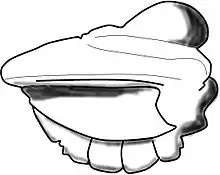Chelediscus
Chelediscus Rushton, 1966, [2] is a genus of Eodiscinid trilobite belonging to the family Weymouthiidae Kobayashi T. (1943), [3] Order Agnostida Salter (1864). [4] The Treatise assigns this genus to the Calodiscidae; Cotton and Fortey (2005) [5] however move it to the Weymouthiidae. Chelediscus lived during the later part of the Botomian stage.[1]

| Chelediscus Temporal range: [1] | |
|---|---|
 | |
| a drawing of a cephalon and pygidium of Chelediscus acifer | |
| Scientific classification | |
| Kingdom: | |
| Phylum: | |
| Class: | |
| Order: | |
| Suborder: | |
| Superfamily: | |
| Family: | |
| Genus: | Chelediscus Rushton, 1966 |
| species | |
| |
. Chelediscus is known from upper lower Cambrian strata in England, Newfoundland, New York State and Russia (Rushton, 1966; Fletcher, 2003;[6] Rasetti, 1967;[7] Jell in Kaesler, 1997;[8]
Distribution
- The Holotype of C. acifer Rushton (1966, p. 19, pl. 2, figs. 26 a - e), is A 57104, held at the Sedgwick Museum of Earth Sciences, University of Cambridge and was collected by Rushton from about 450' above base of the Purley Shale Formation (Protolenus Biozone) at Camp Hill, St. Paul's Church, Stockingford, Nuneaton, Warwickshire, England [Closest ICS interval: Cambrian Series 3 – Terreneuvian Epoch].
C. acifer is also recorded from a Limestone at the top of the Torneträsk Formation, probably Ornamentaspis? linnarssoni Assemblage Zone, in the Luobakti section, south of Lake Torneträsk, northern Swedish Lapland [9] and the lower to middle Brigus Formation (Hupeolenus Zone; Tannudiscus balanus Subzone) at Cape St Mary's, Newfoundland (Fletcher, 2003).
- C. chathamensis Rasetti (1967, p. 46, pl. 3, figs. 11 - 17) was recovered from the Malden Bridge road cut, on Columbia County Route 32, about one mile W. of Malden Bridge, New York State. In the eastern part of the cut, a few medium-grey, granular, 1-3 inch thick limestone beds yielded a rather large Lower Cambrian faunule very similar to the Acimetopus bilobatus faunule from limestone exposures on the Griswold farm, about 1 mile southeast of North Chatham, Columbia County, New York State, USA. The strata holding this faunule are referred to as the Leptochilodiscus punctulatus beds.
References
- SEPKOSKI, J. (2002). "A compendium of fossil marine animal genera (Trilobita entry)". Bulletins of American Paleontology. 364: 560. Archived from the original on 2006-09-05. Retrieved 2008-01-12.
- RUSHTON, A. W. A. 1966. The Cambrian Trilobites from the Purley Shales of Warwickshire Palaeontographical Society Monographs (1): p. 19, pl. 2, figs. 26 a - e.
- KOBAYASHI T. 1943. Brief notes on the Eodiscids 1, their classification with a description of a new species and a new variety, Proceedings of the Imperial Academy, Tokyo, Volume 19, pp. 37-42.
- SALTER, J. W. 1864: On some new fossils from the Lingula-flags of Wales. Quarterly Journal of the Geological Society of London, 20, 233–241.
- COTTON T. J. and FORTEY R. A. Comparative morphology and relationships of the Agnostida. In book: Crustacea and Arthropod Relationships.
- FLETCHER, T. P. 2003. Ovatoryctocara granulata: The key to a global Cambrian Stage boundary and the correlation of the olenellid, redlichiid and paradoxidid realms. In Trilobites and their relatives (eds P. D. Lane, D. J. Siveter & R. A. Fortey), pp. 73–102. Special Papers in Palaeontology no. 70.
- RASETTI, F., 1967. Lower and Middle Cambrian trilobite faunas from the Taconic sequence of New York. Smiths. mise. Coli., 152 (4), pp. 1 - 111, 14 pls.
- KAESLER, R. L. (ed.) 1997. Treatise on Invertebrate Paleontology. Part O. Arthropoda 1. Trilobita, Revised. Volume 1: Introduction, Order Agnostida, Order Redlichiida. Boulder, Colorado and Lawrence, Kansas: Geological Society of America and University of Kansas, 530 pp.
- AXHEIMER, N., AHLBERG P. & CEDERSTRÖM P., 2007. A new lower Cambrian eodiscoid trilobite fauna from Swedish Lapland and its implications for intercontinental correlation. Geol. Mag. 144 (6), 2007, pp. 953 – 961. Cambridge University Press,